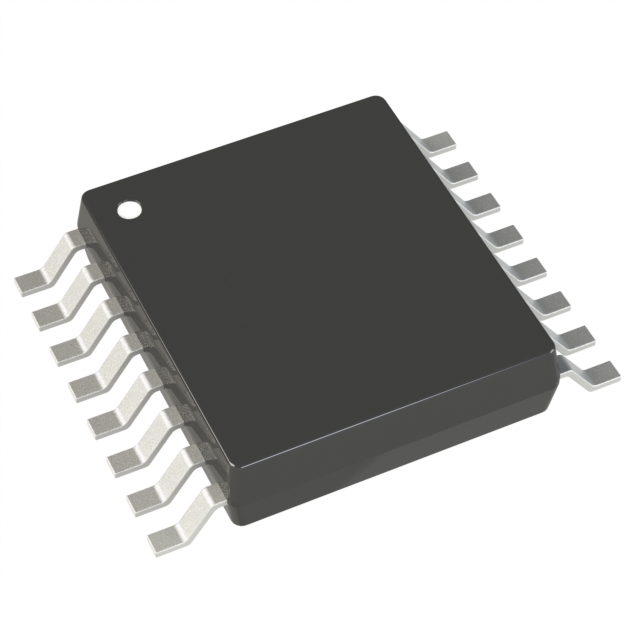Lihat spesifikasi untuk detail produk.

AD5242BRU10-REEL7
Product Overview
Category
The AD5242BRU10-REEL7 belongs to the category of digital potentiometers.
Use
It is commonly used in electronic circuits for controlling resistance values digitally.
Characteristics
- Digital control of resistance
- Compact size
- High resolution
- Low power consumption
Package
The AD5242BRU10-REEL7 comes in a small outline integrated circuit (SOIC) package.
Essence
This product serves as a replacement for traditional mechanical potentiometers, providing precise and reliable resistance control.
Packaging/Quantity
The AD5242BRU10-REEL7 is typically packaged in reels containing 250 units.
Specifications
- Resolution: 10-bit
- Number of Channels: 2
- Resistance Range: 0Ω to 10kΩ
- Supply Voltage: 2.7V to 5.5V
- Operating Temperature Range: -40°C to +125°C
Detailed Pin Configuration
The AD5242BRU10-REEL7 has a total of 16 pins, which are configured as follows:
- VDD: Positive supply voltage
- SDA: Serial data input/output
- SCL: Serial clock input
- A0: Address bit 0
- A1: Address bit 1
- GND: Ground
- VSS: Negative supply voltage
- VLOGIC: Logic supply voltage
- RDAC1: Terminal A of channel 1 resistor
- RDAC2: Terminal B of channel 1 resistor
- RDAC3: Terminal A of channel 2 resistor
- RDAC4: Terminal B of channel 2 resistor
- NC: No connection
- NC: No connection
- NC: No connection
- NC: No connection
Functional Features
- Digital control of resistance values
- Non-volatile memory for storing settings
- I2C-compatible interface for easy integration into digital systems
- Low power consumption for energy-efficient applications
- High resolution for precise resistance adjustments
Advantages and Disadvantages
Advantages
- Precise and reliable resistance control
- Compact size for space-constrained designs
- Non-volatile memory ensures settings are retained even when power is lost
- Easy integration into digital systems with the I2C interface
Disadvantages
- Limited resistance range compared to some other potentiometers
- Higher cost compared to mechanical potentiometers
Working Principles
The AD5242BRU10-REEL7 utilizes a combination of digital-to-analog converters (DACs) and resistive ladder networks to achieve digital control of resistance. The input digital signals are converted into analog voltages, which are then used to adjust the resistance values in the circuit.
Detailed Application Field Plans
The AD5242BRU10-REEL7 finds applications in various fields, including:
- Audio equipment: Used for volume control and tone adjustment in amplifiers and audio mixers.
- Industrial automation: Enables precise control of resistance in industrial control systems and machinery.
- Test and measurement instruments: Provides accurate resistance settings in laboratory equipment and testing devices.
- Automotive electronics: Used in automotive systems for controlling various parameters, such as lighting intensity and motor speed.
Detailed and Complete Alternative Models
- AD5241BRUZ10-REEL7: Similar to AD5242BRU10-REEL7 but with a single channel instead of two.
- AD5244BRUZ10-REEL7: Similar to AD5242BRU10-REEL7 but with four channels instead of two.
- AD8402ARZ10-REEL7: Digital potentiometer with dual-channel and higher resistance range.
These alternative models offer similar functionality and can be considered as alternatives to the AD5242BRU10-REEL7 based on specific application requirements.
Word count: 529 words
Sebutkan 10 pertanyaan dan jawaban umum terkait penerapan AD5242BRU10-REEL7 dalam solusi teknis
Sure! Here are 10 common questions and answers related to the application of AD5242BRU10-REEL7 in technical solutions:
Q: What is the AD5242BRU10-REEL7? A: The AD5242BRU10-REEL7 is a dual-channel, I2C digital potentiometer with 10kΩ resistance.
Q: What is the purpose of the AD5242BRU10-REEL7? A: The AD5242BRU10-REEL7 is used to digitally control resistance in various applications, such as volume control, gain adjustment, and calibration.
Q: How does the AD5242BRU10-REEL7 communicate with other devices? A: The AD5242BRU10-REEL7 communicates using the I2C protocol, allowing it to interface with microcontrollers, DSPs, and other digital devices.
Q: What is the resolution of the AD5242BRU10-REEL7? A: The AD5242BRU10-REEL7 has a 10-bit resolution, providing 1024 steps of resistance adjustment.
Q: Can the AD5242BRU10-REEL7 be used in both audio and non-audio applications? A: Yes, the AD5242BRU10-REEL7 can be used in both audio and non-audio applications where precise resistance control is required.
Q: What is the power supply range for the AD5242BRU10-REEL7? A: The AD5242BRU10-REEL7 operates from a single power supply voltage ranging from 2.7V to 5.5V.
Q: Can the AD5242BRU10-REEL7 be cascaded to increase the number of channels? A: Yes, multiple AD5242BRU10-REEL7 devices can be cascaded together to increase the number of channels in the system.
Q: Does the AD5242BRU10-REEL7 have non-volatile memory? A: Yes, the AD5242BRU10-REEL7 has non-volatile memory that stores the wiper position during power-off.
Q: What is the temperature range for the AD5242BRU10-REEL7? A: The AD5242BRU10-REEL7 operates over a temperature range of -40°C to +125°C.
Q: Are there any evaluation boards or reference designs available for the AD5242BRU10-REEL7? A: Yes, Analog Devices provides evaluation boards and reference designs that can help users quickly prototype and integrate the AD5242BRU10-REEL7 into their applications.
Please note that these answers are general and may vary depending on specific application requirements.

